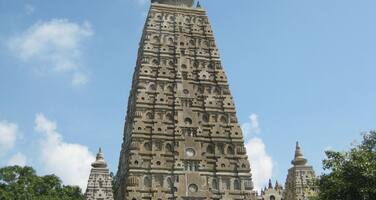Mahabodhi Temple Complex at Bodh Gaya
Factors affecting the property in 2003*
- Deliberate destruction of heritage
- Housing
- Illegal activities
- Impacts of tourism / visitor / recreation
- Management systems/ management plan
- Ritual / spiritual / religious and associative uses
International Assistance: requests for the property until 2003
Total amount approved : 0 USD
Missions to the property until 2003**
Conservation issues presented to the World Heritage Committee in 2003
At the time of inscription of this property on the World Heritage List, the World Heritage Committee noted with concern the information from ICOMOS regarding intense pressure from tourism development and pilgrimage activities on-site. The Committee recommended that the Indian authorities develop a comprehensive management plan to ensure the conservation of the heritage values of the property, including provisions for regular monitoring and adequate mechanisms to control the impact of tourism and pilgrimage activities within and surrounding the property.
Since inscription on the World Heritage List, the Centre has received information from local NGOs and religious groups concerning vandalism and theft on site. Moreover, the Centre has been informed of a number of court cases that reflect some conflictual relationships between the religious groups using the property and occasionally the local communities, which reportedly resulted in fires and riots.
Reportedly, some groups have proposed that the management of the property be placed into the hands of Buddhist religious groups instead of the current local government authority.
Summary of the interventions
Decisions adopted by the Committee in 2003
27 COM 7B.46
Mahabodhi Temple Complex at Bodh Gaya (India)
The World Heritage Committee,
1. Having examined the state of conservation of the property for the first time since its inscription on the World Heritage List in 2002,;
2. Recalling the concern at the time of inscription regarding the tourism and pilgrimage pressures facing the property,;
3. While noting that the absence of a functioning comprehensive management plan has persisted in spite of the Committee's recommendation at the time of inscription of the property for the development of such plan (26 COM 23.16), expresses its appreciation to the State Party for commencing the elaboration of such a plan,;
4. Expresses concern over the continuing tensions and occasional conflicts between local stakeholders, in particular the religious groups who wish to use this important religiousWorld Heritage property;
5. Recognizing the associated heritage significance of the surrounding areas of the Mahabodhi Temple which are intrinsically linked to the enlightenment of Buddha, but which are not within the core nor the buffer zone of the existing World Heritage property,;
6. Invites the State Party to enlarge the World Heritage protected area to ensure that the protective core and buffer zones are meaningful and effective for the conservation of the values of the property;
7. Requests the State Party to complete the elaboration of a comprehensive management plan which adequately integrates:
(a) Local community and stakeholders' dialogue and co-operation,
(b) Protection, conservation and preservation of the heritage value and assets of this sacred property,
(c) Control of development activities within and surrounding the property related to tourism and pilgrimage activities;
8. Requests the State Party to submit to the World Heritage Centre by 1 February 2004 the completed comprehensive management plan in order that the World Heritage Committee can examine the state of conservation of the property at its 28th session in 2004.
Draft Decision: 27 COM 7 (b) 46
The World Heritage Committee,
1. Having examined the state of conservation of the property for the first time since its inscription on the World Heritage List in 2002,
2. Recalling the concern at the time of inscription concerning the tourism and pilgrimage pressures facing the property,
3. Noting that the absence of a functioning comprehensive management plan has persisted,
4. Expresses concern over the continuing tensions and occasional conflicts between local stakeholders, in particular the religious groups who wish to use this important religious World Heritage property;
5. Recognizing the associated heritage values of the surrounding areas of the Mahabodhi Temple which are intrinsically linked to the enlightenment of Buddha which are not within the core nor the buffer zone of the existing WH property;
6. Requests the State Party to enlarge the World Heritage protected area to ensure that the protective core and buffer zones are meaningful and effective for the conservation of the values of the property;
7. Requests the State Party to urgently commence the elaboration of a comprehensive management plan which adequately integrates:
a. Local community and stakeholders' dialogue and co-operation;
b. Protection, conservation and preservation of the heritage values and assets of this sacred property;
c. Control of development activities within and surrounding the property related to tourism and pilgrimage activities;
8. Decides to examine the state of conservation of the property at its 28th session.
Exports
* :
The threats indicated are listed in alphabetical order; their order does not constitute a classification according to the importance of their impact on the property.
Furthermore, they are presented irrespective of the type of threat faced by the property, i.e. with specific and proven imminent danger (“ascertained danger”) or with threats which could have deleterious effects on the property’s Outstanding Universal Value (“potential danger”).
** : All mission reports are not always available electronically.


